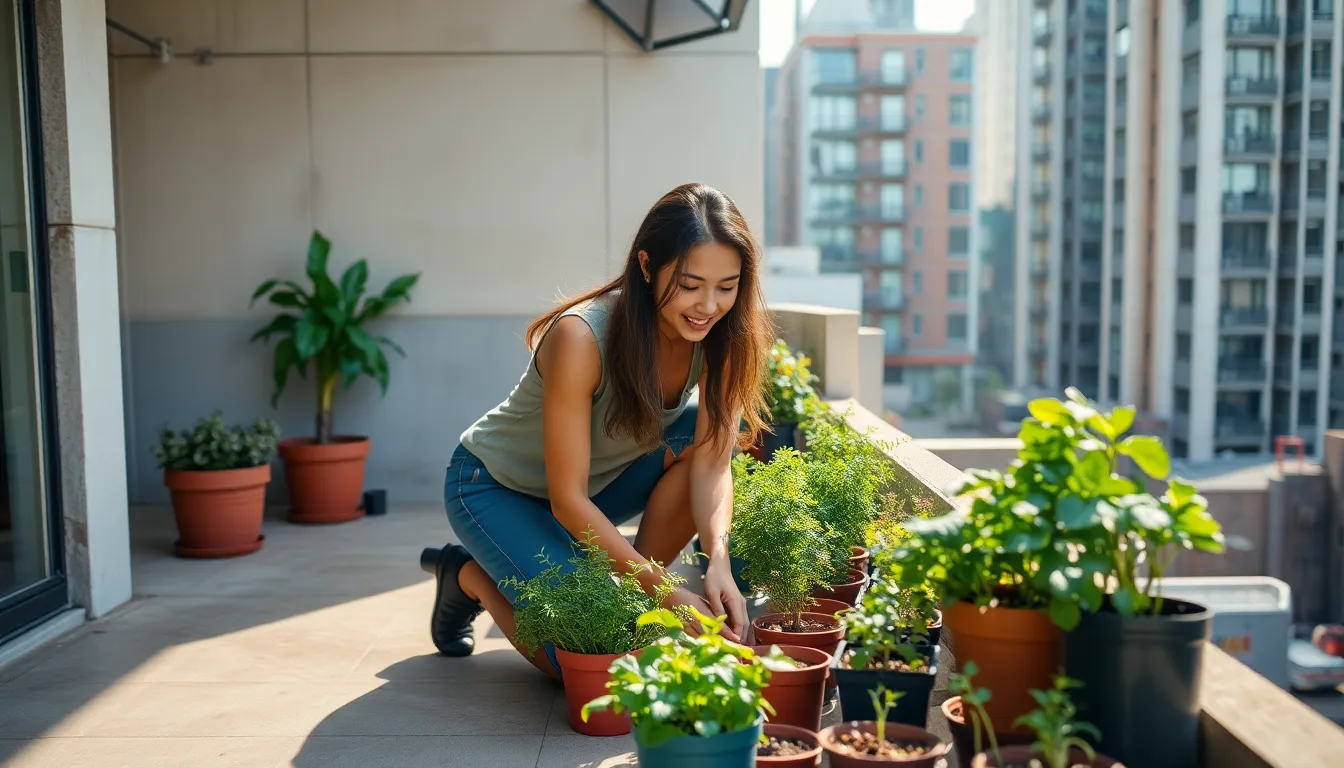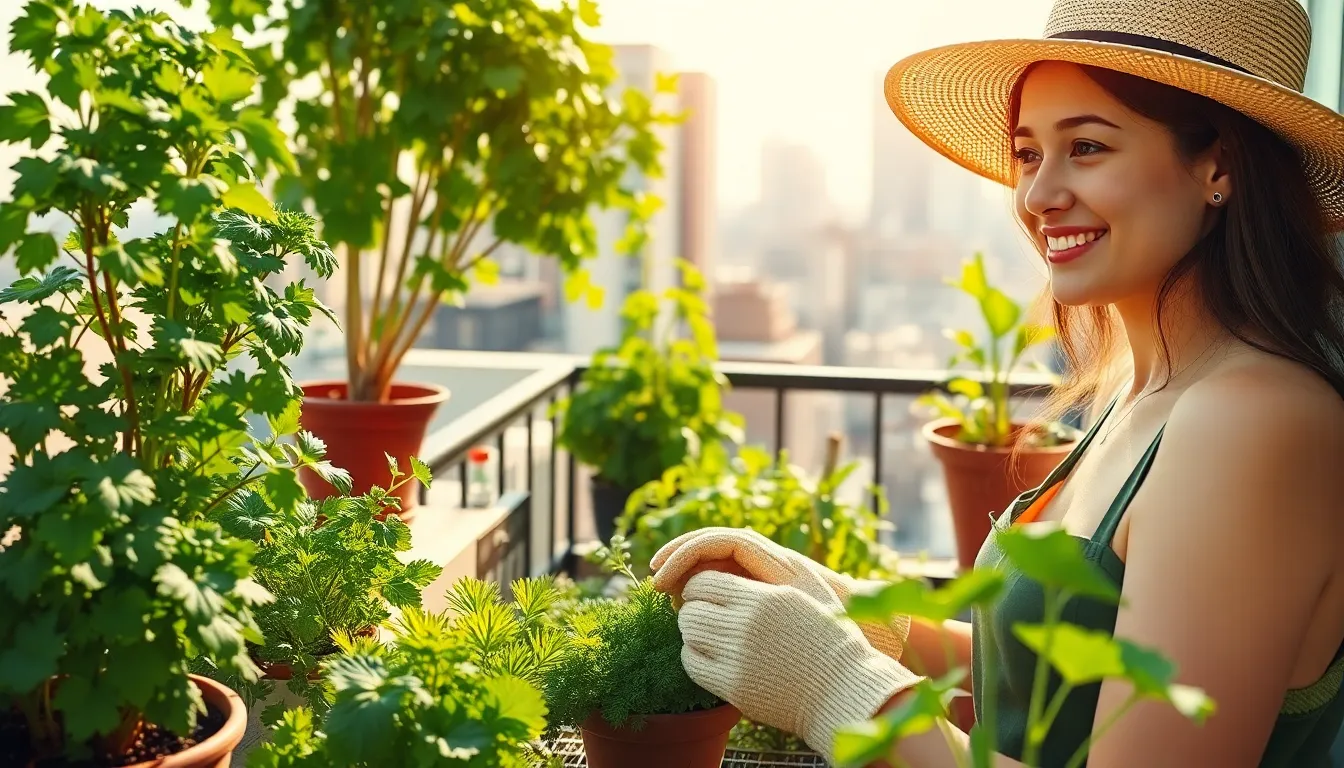In a world where concrete reigns supreme, city gardening emerges as a delightful rebellion against the urban jungle. Picture this: a tiny balcony bursting with vibrant tomatoes, or a rooftop oasis where herbs flourish like they own the place. City gardening isn’t just a trend; it’s a green revolution that transforms asphalt into edible landscapes.
City Gardening
City gardening offers numerous advantages, enhancing both individual well-being and the urban landscape. This approach to urban living supports healthier environments and promotes overall quality of life.
Environmental Impact
Urban gardens significantly reduce air pollution by filtering harmful pollutants. Plants absorb carbon dioxide and release oxygen, contributing to cleaner air. Biodiversity thrives in city gardens, supporting various species of insects, birds, and beneficial microorganisms. Rainwater runoff decreases as gardens capture water, mitigating flooding risks in urban areas. Additionally, growing food locally lessens reliance on transportation, reducing carbon footprints. These practices foster sustainable habits and inspire community engagement with nature.
Mental Health Advantages
Engaging in city gardening can alleviate stress and anxiety. Green spaces promote relaxation, creating a calming atmosphere that encourages mindfulness. Physical activity occurs naturally while tending to plants, boosting mood and energy levels. Connecting with nature fosters a sense of purpose and fulfillment. Gardeners often find joy in nurturing plants, which cultivates patience and resilience. Social interactions blossom within community gardens, offering support and building relationships among participants. Empowerment and accomplishment arise from growing food, enhancing overall mental well-being.
Getting Started With City Gardening

City gardening creates a vibrant contrast to urban concrete. Each step involves thoughtful planning and choices for optimal results.
Choosing the Right Space
Identifying the ideal gardening space is crucial. Balconies, rooftops, and window sills often provide excellent opportunities. Sunlight exposure determines plant health, so assess light conditions throughout the day. Additionally, consider access to water sources; convenience aids maintenance. Evaluate safety and privacy as well, especially on higher levels. Nearby structures may create shade that impacts growth. Utilize these factors to transform any small area into a flourishing garden.
Selecting Plants for Urban Environments
Opt for plants that thrive in limited spaces. Herbs, like basil and mint, grow well in containers and offer culinary benefits. Vegetables, such as cherry tomatoes and radishes, adapt to small plots and pots. Drought-resistant plants also suit urban settings, reducing water needs. Check local climate conditions before making selections; hardy varieties perform better in specific environments. Mix ornamental plants with edible choices to increase visual appeal. Emphasizing these considerations ensures a successful city garden.
Gardening Techniques for Urban Spaces
City gardening thrives on innovative techniques that make the most of limited space. Two effective methods stand out: container gardening and vertical gardening.
Container Gardening
Container gardening suits urban dwellers with restricted space. Pots, barrels, and boxes hold soil and plants, allowing flexibility in placement. Individuals can arrange containers on balconies, patios, or window sills to maximize sunlight exposure. Numerous plants thrive in containers, such as tomatoes, basil, and peppers. Drainage holes ensure excess water escapes, preventing root rot. Regularly monitoring moisture levels remains crucial for plant health. With the right mix of potting soil and fertilizer, container gardens yield abundant harvests.
Vertical Gardening
Vertical gardening utilizes space efficiently by growing plants upward. Wall-mounted planters, trellises, and hanging pots create stunning green displays. This technique particularly suits areas with limited ground space. Climbers like beans and cucumbers flourish in vertical setups, while succulents and ferns work well in wall planters. Utilizing vertical space encourages air circulation, reducing the risk of disease. Savvy gardeners can incorporate recycled materials, such as wooden pallets, creating eco-friendly solutions. Creating eye-catching designs adds beauty and freshness to urban environments.
Community Involvement in City Gardening
Community involvement plays a crucial role in the success of city gardening. Engagement fosters a shared sense of ownership and responsibility among residents.
Local Gardening Groups
Local gardening groups create vibrant networks in urban areas. These groups connect individuals who share a passion for gardening, offering a platform for knowledge exchange and support. Members participate in hands-on workshops, share resources like seeds and tools, and collaborate on community garden projects. They often designate specific spaces for gardening, enhancing the neighborhood’s visual appeal and biodiversity. Relationships built within these groups encourage citizens to take an active role in caring for their environment, promoting sustainability.
Urban Gardening Events
Urban gardening events attract diverse participants eager to learn and contribute. Workshops on sustainable practices, plant care, or design techniques often take place in public parks or community centers. These events provide educational opportunities while showcasing successful urban gardening projects. Demonstrations highlight innovative techniques like vertical gardening and container gardening, inspiring attendees to start their own projects. Festivals celebrating local produce foster a sense of community, emphasizing the importance of fresh, locally grown food.
Conclusion
City gardening is more than just a trend; it’s a movement that reshapes urban living. By transforming small spaces into green sanctuaries, individuals can cultivate not only plants but also a sense of community and well-being. The benefits extend beyond personal satisfaction, contributing to a healthier environment and fostering connections among neighbors.
As urban dwellers embrace innovative gardening techniques, they’re not only enhancing their surroundings but also promoting sustainability. Engaging with nature in the city nurtures mental health and encourages a lifestyle rooted in mindfulness. With every seed planted, city gardening helps create a vibrant tapestry of green in the concrete jungle, proving that even the smallest spaces can thrive with life.

